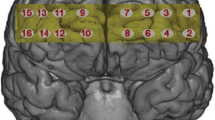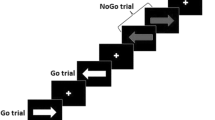Abstract
Rationale
Heavy ecstasy use in humans has been associated with cognitive impairments and changes in cognitive brain function supposedly due to damage to the serotonin system. There is concern that even a single dose of 3,4-methylenedioxymethamphetamine may be neurotoxic, but very little is known about the consequences of a low dose of ecstasy for cognitive brain function.
Objectives
The objective of the study was to assess the effects of a low dose of ecstasy on human cognitive brain function using functional magnetic resonance imaging (fMRI).
Materials and method
We prospectively studied, as part of the NeXT (Netherlands XTC toxicity) study, sustained effects of a low dose of ecstasy on brain function in 25 subjects before and after their first episode of ecstasy use (mean 2.0 ± 1.4 ecstasy pills, on average 11.1 ± 12.9 weeks since last ecstasy use), compared to 24 persistent ecstasy-naive controls, also measured twice and matched with the novice users on age, gender, IQ, and cannabis use. Cognitive brain function was measured in the domains of working memory, selective attention, and associative memory using fMRI.
Results
No significant effects were found of a low dose of ecstasy on working memory, selective attention, or associative memory neither at the behavioral level nor at the neurophysiological level.
Conclusions
This study yielded no firm evidence for sustained effects of a low dose of ecstasy on human cognitive brain function. The present findings are relevant for the development of prevention and harm reduction strategies. Furthermore, the study is relevant to the discussion concerning potential therapeutic use of ecstasy.





Similar content being viewed by others
Notes
MAPS Research Information at http://www.maps.org/mdma/ for information on approved phase I and II studies.
Advertisements were placed on the internet, on a special website for this study from the Academic Medical Center Amsterdam and by a pop-up advertising campaign on the Microsoft MSN Network.
NDM 2004 at http://www.trimbos.nl/.
References
Adori C, Ando RD, Kovacs GG, Bagdy G (2006) Damage of serotonergic axons and immunolocalization of Hsp27, Hsp72, and Hsp90 molecular chaperones after a single dose of MDMA administration in Dark Agouti rat: temporal, spatial, and cellular patterns. J Comp Neurol 497:251–269
Audoin B, Van Au DM, Malikova I, Confort-Gouny S, Ibarrola D, Cozzone PJ, Pelletier J, Ranjeva JP (2006) Functional magnetic resonance imaging and cognition at the very early stage of MS. J Neurol Sci 245:87–91
Bolla KI, Eldreth DA, Matochik JA, Cadet JL (2005) Neural substrates of faulty decision-making in abstinent marijuana users. Neuroimage 26:480–492
Cole JC, Sumnall HR (2003) Altered states: the clinical effects of ecstasy. Pharmacol Ther 98:35–58
Collins DL, Neelin P, Peters TM, Evans AC (1994) Automatic 3D intersubject registration of MR volumetric data in standardized Talairach space. J Comput Assist Tomogr 18:192–205
Cowan RL (2007) Neuroimaging research in human MDMA users: a review. Psychopharmacology (Berl) 189:539–556
Daumann J, Schnitker R, Weidemann J, Schnell K, Thron A, Gouzoulis-Mayfrank E (2003) Neural correlates of working memory in pure and polyvalent ecstasy (MDMA) users. Neuroreport 14:1983–1987
Daumann J Jr, Fischermann T, Heekeren K, Thron A, Gouzoulis-Mayfrank E (2004) Neural mechanisms of working memory in ecstasy (MDMA) users who continue or discontinue ecstasy and amphetamine use: evidence from an 18-month longitudinal functional magnetic resonance imaging study. Biol Psychiatry 56:349–355
Daumann J, Fischermann T, Heekeren K, Henke K, Thron A, Gouzoulis-Mayfrank E (2005) Memory-related hippocampal dysfunction in poly-drug ecstasy (3,4-methylenedioxymethamphetamine) users. Psychopharmacology (Berl) 180:607–611
De Win MM, Jager G, Vervaeke HK, Schilt T, Reneman L, Booij J, Verhulst FC, Den Heeten GJ, Ramsey NF, Korf DJ, van den Brink W (2005) The Netherlands XTC Toxicity (NeXT) Study: objectives and methods of a study investigating causality, course, and clinical relevance. Int J Methods Psychiatr Res 14:167–185
De Win MM, Reneman L, Jager G, Vlieger EP, Olabarriaga SD, Lavini C, Bisschops I, Majoie CB, Booij J, den Heeten GJ, van den Brink W (2007) A prospective cohort study on sustained effects of low-dose ecstasy use on the brain in new ecstasy users. Neuropsychopharmacology 32:458–470
Dumont GJ, Verkes RJ (2006) A review of acute effects of 3,4-methylenedioxymethamphetamine in healthy volunteers. J Psychopharmacol 20:176–187
Easton N, Marsden CA (2006) Ecstasy: are animal data consistent between species and can they translate to humans? J Psychopharmacol 20:194–210
Gijsman HJ, Verkes RJ, Van Gerven JM, Cohen AF (1999) MDMA study. Neuropsychopharmacology 21:597
Gouzoulis-Mayfrank E, Daumann J (2006) Neurotoxicity of methylenedioxyamphetamines (MDMA; ecstasy) in humans: how strong is the evidence for persistent brain damage? Addiction 101:348–361
Green AR, Mechan AO, Elliott JM, O’Shea E, Colado MI (2003) The pharmacology and clinical pharmacology of 3,4-methylenedioxymethamphetamine (MDMA, “ecstasy”). Pharmacol Rev 55:463–508
Hampson AJ, Grimaldi M, Lolic M, Wink D, Rosenthal R, Axelrod J (2000) Neuroprotective antioxidants from marijuana. Ann N Y Acad Sci 899:274–282
Henke K, Buck A, Weber B, Wieser HG (1997) Human hippocampus establishes associations in memory. Hippocampus 7:249–256
Jacobsen LK, Pugh KR, Constable RT, Westerveld M, Mencl WE (2007) Functional correlates of verbal memory deficits emerging during nicotine withdrawal in abstinent adolescent cannabis users. Biol Psychiatry 61(1):31–40
Jager G, Kahn RS, van den Brink W, van Ree JM, Ramsey NF (2006) Long-term effects of frequent cannabis use on working memory and attention: an fMRI study. Psychopharmacology (Berl) 185:358–368
Jager G, van Hell HH, de Win MM, Kahn RS, van den Brink W, van Ree JM, Ramsey NF (2007a) Effects of frequent cannabis use on hippocampal activity during an associative memory task. Eur Neuropsychopharmacol 17:289–297
Jager G, de Win MM, van der Tweel I, Schilt T, Kahn RS, den Brink W, van Ree JM, Ramsey NF (2007b) Assessment of cognitive brain function in ecstasy users and contributions of other drugs of abuse: results from an fMRI study. Neuropsychopharmacology (Apr 25, in press)
Jansma JM, Ramsey NF, Slagter HA, Kahn RS (2001) Functional anatomical correlates of controlled and automatic processing. J Cogn Neurosci 13:730–743
Jansma JM, Ramsey NF, van der Wee NJ, Kahn RS (2004) Working memory capacity in schizophrenia: a parametric fMRI study. Schizophr Res 68:159–171
Johnson MR, Morris NA, Astur RS, Calhoun VD, Mathalon DH, Kiehl KA, Pearlson GD (2006) A functional magnetic resonance imaging study of working memory abnormalities in Schizophrenia. Biol Psychiatry 60(1):11–21
Kish SJ (2002) How strong is the evidence that brain serotonin neurons are damaged in human users of ecstasy? Pharmacol Biochem Behav 71:845–855
Lamers CT, Ramaekers JG, Muntjewerff ND, Sikkema KL, Samyn N, Read NL, Brookhuis KA, Riedel WJ (2003) Dissociable effects of a single dose of ecstasy (MDMA) on psychomotor skills and attentional performance. J Psychopharmacol 17:379–387
Matochik JA, London ED, Eldreth DA, Cadet JL, Bolla KJ (2003) Frontal cortical tissue composition in abstinent cocaine abusers: a magnetic resonance imaging study. Neuroimage 19:1095–1102
McCann UD, Ricaurte GA (2001) Caveat emptor: editors beware. Neuropsychopharmacology 24:333–336
Moeller FG, Steinberg JL, Dougherty DM, Narayana PA, Kramer LA, Renshaw PF (2004) Functional MRI study of working memory in MDMA users. Psychopharmacology (Berl) 177:185–194
Myrick H, Anton RF, Li X, Henderson S, Drobes D, Voronin K, George MS (2004) Differential brain activity in alcoholics and social drinkers to alcohol cues: relationship to craving. Neuropsychopharmacology 29:393–402
O’Shea E, Granados R, Esteban B, Colado MI, Green AR (1998) The relationship between the degree of neurodegeneration of rat brain 5-HT nerve terminals and the dose and frequency of administration of MDMA (‘ecstasy’). Neuropharmacology 37:919–926
Parrott AC (2001) Human psychopharmacology of ecstasy (MDMA): a review of 15 years of empirical research. Hum Psychopharmacol 16:557–577
Parrott AC, Gouzoulis-Meyfrank E, Rodgers J, Solowij N (2004) Ecstasy/MDMA and cannabis: the complexities of their interactive neuropsychobiological effects. J Psychopharmacol 18:572–575
Ramsey NF, van den Brink JS, van Muiswinkel AM, Folkers PJ, Moonen CT, Jansma JM, Kahn RS (1998) Phase navigator correction in 3D fMRI improves detection of brain activation: quantitative assessment with a graded motor activation procedure. Neuroimage 8:240–248
Ramsey NF, Jansma JM, Jager G, Van Raalten T, Kahn RS (2004) Neurophysiological factors in human information processing capacity. Brain 127:517–525
Ricaurte GA, DeLanney LE, Irwin I, Langston JW (1988) Toxic effects of MDMA on central serotonergic neurons in the primate: importance of route and frequency of drug administration. Brain Res 446:165–168
Rodgers J, Buchanan T, Scholey AB, Heffernan TM, Ling J, Parrott AC (2003) Patterns of drug use and the influence of gender on self-reports of memory ability in ecstasy users: a web-based study. J Psychopharmacol 17:389–396
Schilt T, de Win MM, Koeter M, Jager G, Korf DJ, van den Brink W, Schmand B (2007) Cognition in novice Ecstasy users with minimal exposure to other drugs: a prospective cohort study. Arch Gen Psych (in press)
Schmand B, Bakker D, Saan R, Louman J (1991) [The Dutch reading test for adults: a measure of premorbid intelligence level]. Tijdschr Gerontol Geriatr 22:15–19
Scholey AB, Parrott AC, Buchanan T, Heffernan TM, Ling J, Rodgers J (2004) Increased intensity of ecstasy and polydrug usage in the more experienced recreational ecstasy/MDMA users: a WWW study. Addict Behav 29:743–752
Sheehan DV, Lecrubier Y, Sheehan KH, Amorim P, Janavs J, Weiller E, Hergueta T, Baker R, Dunbar GC (1998) The mini-international neuropsychiatric interview (M.I.N.I.): the development and validation of a structured diagnostic psychiatric interview for DSM-IV and ICD-10. J Clin Psychiatry 59(Suppl 20):22–33
Sinor AD, Irvin SM, Greenberg DA (2000) Endocannabinoids protect cerebral cortical neurons from in vitro ischemia in rats. Neurosci Lett 278:157–160
Talairach J, Tournoux P (1988) Co-planar stereotaxic atlas of the human brain. Thieme, New York
Van de Wijngaart G, Braam R, de Bruin D, Fris M, Maalste NJM, Verbraec HT (1997) Ecstasy in het uitgaanscircuit (Ecstasy and the Dutch rave scene: a socio-epidemiologic study on the nature and extent of, and the risks involved in using ecstasy and other party drugs at dance events). Addiction Research Center Utrecht, The Netherlands
Van der Wee NJ, Ramsey NF, Jansma JM, Denys DA, van Megen HJ, Westenberg HM, Kahn RS (2003) Spatial working memory deficits in obsessive compulsive disorder are associated with excessive engagement of the medial frontal cortex. Neuroimage 20:2271–2280
Verbaten MN (2003) Specific memory deficits in ecstasy users? The results of a meta-analysis. Hum Psychopharmacol 18:281–290
Vervaeke HK, Korf DJ, Benschop A, van den Brink W (2006) How to find future ecstasy users: targeted and snowball sampling in an ethically sensitive context. Addict Behav (Dec 22, in press)
Worsley KJ, Friston KJ (1995) Analysis of fMRI time-series revisited-again. Neuroimage 2:173–181
Acknowledgments
This work was supported by a grant of The Netherlands Organization for Health Research and Development as part of their Addiction Program (ZonMW 310-00-036). We thank Microsoft MSN Network for their generous support concerning the internet pop-up advertisement campaign. We thank Dirk Korf for his valuable contribution to the design of the study, and finally, we thank Jeske Damoiseaux, Mieke Deenen, Judith Bosman, Rianne Petersen, Erika van Hell, and Lenny Ramsey for their assistance with data collection and analyses.
Author information
Authors and Affiliations
Corresponding author
Rights and permissions
About this article
Cite this article
Jager, G., de Win, M.M., Vervaeke, H.K. et al. Incidental use of ecstasy: no evidence for harmful effects on cognitive brain function in a prospective fMRI study. Psychopharmacology 193, 403–414 (2007). https://doi.org/10.1007/s00213-007-0792-1
Received:
Accepted:
Published:
Issue Date:
DOI: https://doi.org/10.1007/s00213-007-0792-1




